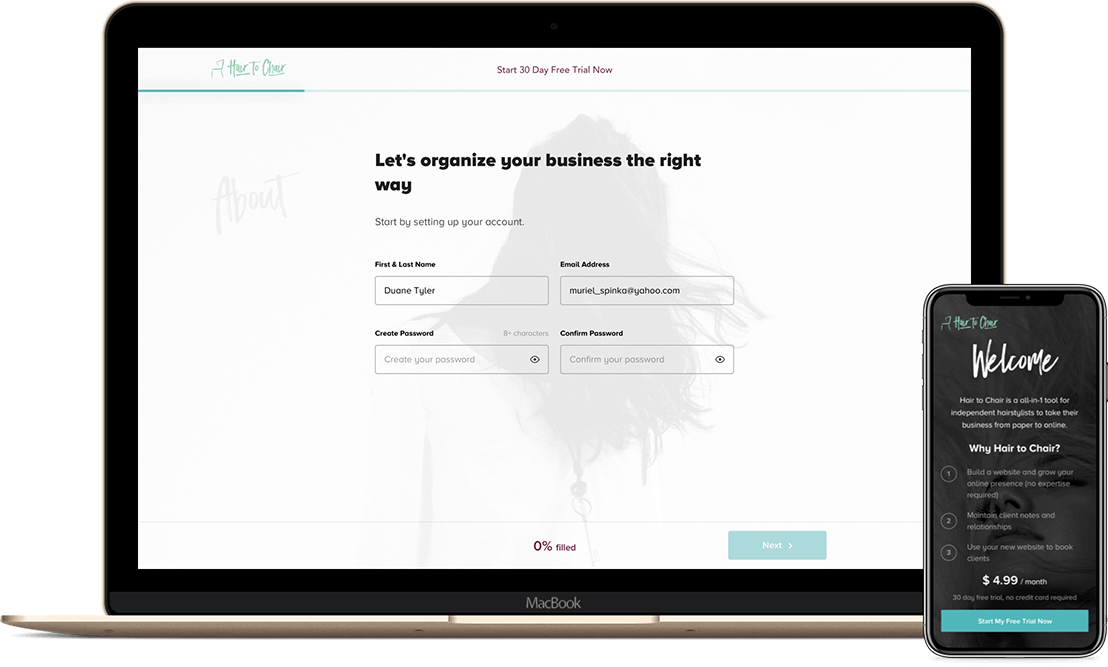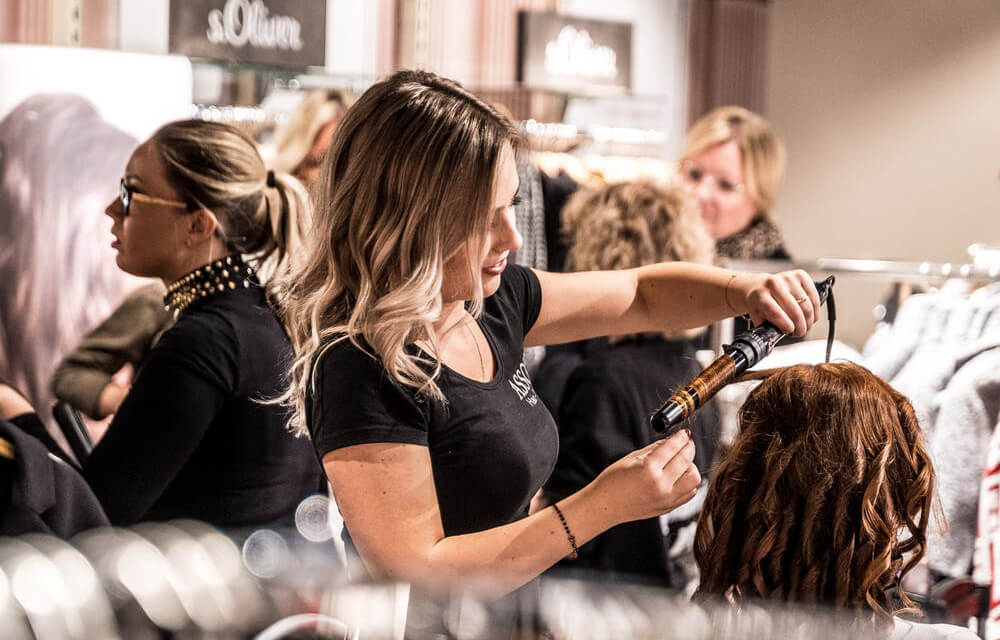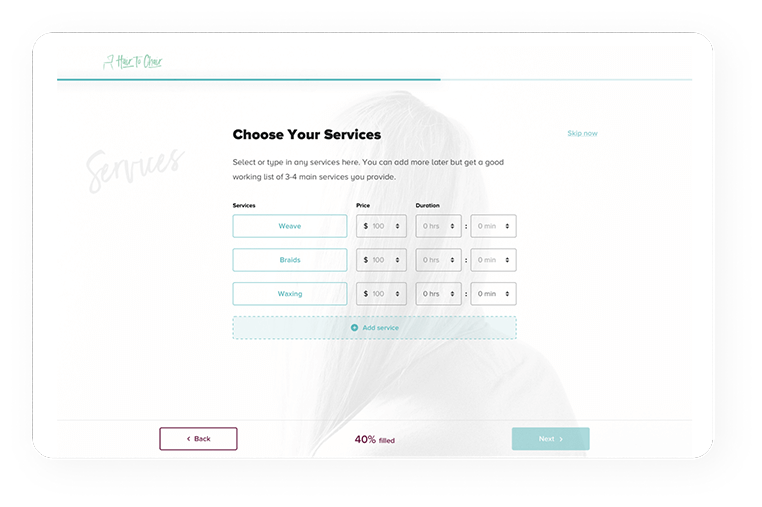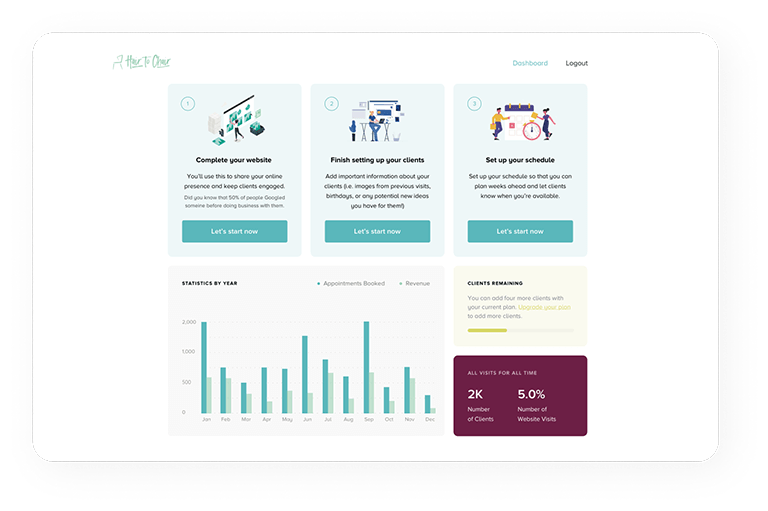Hair to Chair
User Research, UI/UX design
Case study
Case study
TOOLS USED
Website
Hair to Chair began as an app for independent hairstylists to take their business from paper to online. While it quickly gained users after launching, they knew a pivot would be necessary after noticing that most users stopped engaging with the app within a few weeks. Hair to Chair teamed up with Northpeak in the hopes that we could enable product-market fit and guide the design of the app.
We did this by pulling out all the stops with research. We leaned on Silicon Valley-tested techniques, brought in academic and tech experts, and pounded the pavement asking strangers for interviews.
Market validation takes longer than most people think, but through our process, Northpeak was able to articulate Hair to Chair’s problems and identify a new market before making recommendations for the redesign. Now, Hair to Chair is an all-in-one leader for hairstylists on the rise.
Background
Hair to Chair is an all-in-one tool for independent hairstylists to take their business from paper to online.

The Challenge
Hair to Chair launched in early 2018, and quickly gained users. However, by midyear, they decided to pivot after most users stopped engaging with the app after a few weeks. The mistake they had made was creating functionality without proper feedback from intended target users.
Northpeak was brought on to guide the design of the product and enable product-market fit.
Questions we were seeking to answer:
- What problems, needs, and motivations do stylists have?
- Do people understand H2C’s value proposition?
- Which messages are most effective at explaining your product?
- Can people figure out how to use your product?
- Why do people stop using your product?
- Are you targeting the right population?

The Solution
Our goal was to identify gaps and opportunities that would help Hair to Chair become a leader in the hairstylist space. By using an agile methodology to conduct user research and UI/UX sprints, we created a product that better aligned with hairstylists’ goals.

Hairstylists, in their very essence, are in the business of serving people and using their creative skills to create visually appealing work. They are often not experienced managers or tech-savvy, and some struggle setting up calendars, creating websites, and running marketing campaigns.
Because of this and the fact the beauty space is already filled with endless online booking systems and expensive tools with poor UX experiences, we were hesitant to build another booking tool. We wanted to create a more human and simple experience that positioned Hair to Chair as an innovator and thought leader in the space.
The big unknown was what exactly should the core value proposition of Hair to Chair be? We didn’t have an answer from the start but we knew that our path would begin with user experience research. The solution was an iterative and data-driven process that entailed two weeks of user research sprints, followed by two weeks of design and development.
Northpeak runs user research and design sprints similarly to how many Silicon Valley startups and venture arms like Google Ventures practice. We started by researching the hairstylist space using google and publicly available information. We also used paid tools and looked at competitor behavior and strategies. Next, and maybe most importantly, we conducted in-person interviews to better understand hairstylists’ problems, needs, and desires.
Understanding their problems was a must before thinking about a solution. Northpeak brought in Dr. Leo Hoar, a former Ohio State professor and UX research expert who’s worked with companies like Samsung and Beam Dental. We used our initial research to set up a study protocol with questions and assumptions that would help us uncover the insights needed to better serve user needs. After going through a few dry runs, it was time to recruit and schedule interviews with different cohorts of users.
The interviews included starter questions like:
- ‘’What’s your favorite thing about this job?”
- “What are the biggest challenges you face as a stylist?”
- “How did you deal with those challenges?”
These simpler questions allow individuals to open up and make it more of a conversation, which is how it should feel. It shouldn’t feel like an intense or awkward interview.
From there we moved to questions that explored their initial thoughts about the Hair to Chair website and the onboarding process. We asked them unbiased questions like
- “In your opinion, what does this site offer you?”
- “What do you feel like doing next?”
We took the prospective user through the key features of the application to understand what they liked and what they didn’t like. We made it clear to the hairstylists that we didn’t make the site and they wouldn’t hurt our ego or make us feel awkward if they found the user experience clunky or slow. From there, we started to make changes to the application and conduct another sprint of user research, building off of the last one.

After four sprints, we had a much better understanding of the problems hairstylists faced and the different types of personas Hair to Chair had to consider.

Results
We learned that hairstylists who live in cities or heavily populated areas likely already had an existing booking system and maybe even a website for their business. However, these were individuals with more access to resources and willing to pay higher fees. The real opportunity was to help those newer hairstylists who lived right outside the city, maybe with less resources, but just as hungry to grow their career.

We discovered that as much as we didn’t want Hair to Chair to complete in the already crowded booking space, that aspect of the tool was a priority (and in some cases a deal-breaker) for hairstylists considering any paid tool.
We originally hypothesized that hairstylists would care most about increasing business and generating leads. However, through our sprints, we discovered more business and new customers were lower on the priority list for young stylists living in urban areas. What they needed was help managing their business and existing clients.
That’s when the light bulb moment went off: Hair to Chair wasn’t a social tool or another marketplace for hairstylists, rather a business management tool that made life easier for hairstylists. The benefit was that newer specialized hairstylists could take their business digital and grow their online presence with little-to-no technology background.
We also learned that our target audience was sometimes familiar with social media but was not, in general, a tech-savvy individual. This meant we had to simplify the initial experience and the onboarding process specifically. We developed a streamlined onboarding flow using design sprints that communicated the benefits of the Hair to Chair tool in a simple and personalized way.

Market validation, when fueled by thoughtful and strategic research, can take longer than is commonly thought. But the amazing part of this simple process was that we received direct feedback from our target audience. We removed guesswork and significantly reduced the build, measure, and learning cycle.
We also built a dashboard that was easy to understand. It showed users how to use the application and how each feature could help them. The feedback and data-driven approach allowed us to validate the existence of a market for Hair to Chair and build a tool that would ultimately help hairstylists manage their clients. Hair to Chair is now positioned as an all-in-one leader for ‘on-the-rise’ hairstylists.
